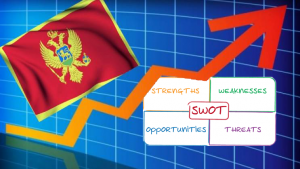 Crnogorski
Crnogorski English available languages
English available languages
Small countries, i.e. small economies are rather sensitive to the influence of international environment. This especially applies to countries like Montenegro, in which the use of euro as a legal tender additionally limits the maneuvering space in case of potential external shocks. Therefore, it is important, seems even more important than in any large economy, for Montenegro to have a clear vision, i.e. strategy for medium-term as well as long-term growth and development. There are a variety of economic methods and techniques used in developing these strategies, such as SWOT analysis.
 SWOT analysis is an analytical method for identifying significant internal and external factors
SWOT analysis is an analytical method for identifying significant internal and external factors
of an organization, area, territory, etc. which affect their development. Through focusing on its
four integral elements: strength, weakness, opportunity and threat, this analysis enables the identification and maximum utilization of strengths and opportunities of an economy, and minimization of weaknesses and threats. SWOT analyses find application on micro and on macro level, even on the level of an entire economy of a country.
Compiled SWOT table, i.e. the analysis of Montenegro’s economy reveals numerous strengths and opportunities typical of a small economy. Nevertheless, all small economies, especially those with low competitiveness, fall under the considerable influence of larger economic systems.
Central bank of Montenegro has defined MONTENEGRO’S ECONOMY SWOT ANALYSIS matrix as following:
Strengths
• Natural resource wealth – potential for FDI attraction
• Euro as a legal tender
• Liquid and solvent banking system
• Cessation of the negative lending activity trend
• Low customs duty rates
• Low tax rates
• Potential for the development of tourism,
energy industry, and agriculture
• EU candidate status – access to funds
Weaknesses
• Persistent real sector illiquidity
• Although considerably reduced – still high level
of non-performing loans (NPL)
• Albeit declining – still high interest rates
• Unused credit potential of banks
• Inconsistent regional development
• Underdeveloped infrastructure
• Rigid labor market and unemployment
• High FDI dependency, low levels of greenfield
investments, and investments in production
• Low and not diversified exports
• Dependency on imports and unfavorable
imports structure
• High level of public debt
• Shadow Economy
• Tax evasion
Opportunities
• Change in the structure of bank financing in favor of deposits
• Increase of competitiveness through the introduction of new banks into Montenegro’s market
• Resolution of NPLs through the “Podgorica approach”
• Drinking water springs and good water, air and soil pollution protection
• Agricultural production potentials – strengthening of processing sector in agriculture
• Wood-processing industry and production of finished wood products
• Potential for the development of low carbon tourism
• Planned development projects, especially in
the sectors of tourism and energy
• Actualization of major infrastructure projects
• Tax debt collection
• Attraction of FDI in production industries
Threats
• Further public debt growth
• Threats of issued state guarantees being called upon
• High level of fiscal deficit
• Lower FDI inflow, low level of reinvestment and potential foreign capital outflow
• Decline in external demand (exports and tourism revenues)
Source: Central Bank of Montenegro (CBCG)
 Crnogorski
Crnogorski English available languages
English available languages
